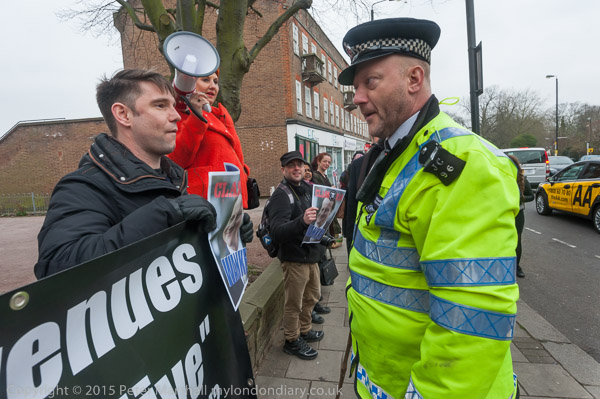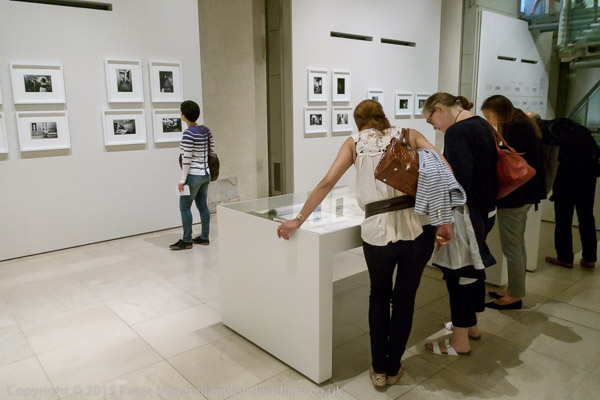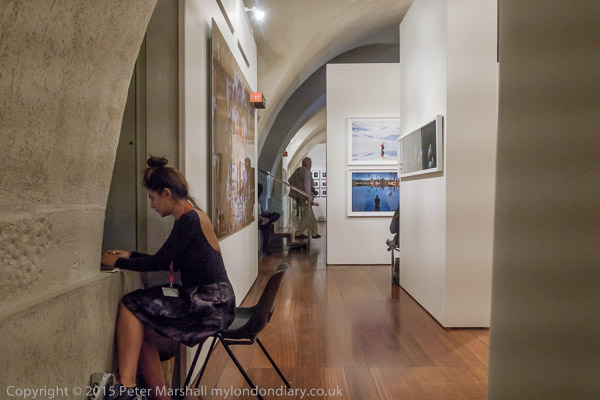
It seems a long time now since the General Election on May 7, and the shock of waking up the morning after to find the Conservatives were in power. Not that I have any great faith in Labour, but anything would have been better than a Tory majority.
Of course there was no chance that Class War would sweep to power. They were only standing in seven seats and when party leader Ian Bone talked at the party’s election launch about hoping to get into double figures he was talking about votes, not seats. And even for rather more serious parties – like the Greens – getting more than a million votes doesn’t give you proper representation, still just the one seat won by Caroline Lucas in Brighton. And if Labour had put the kind of effort they put into trying to unseat her into their fight against the Conservatives, the election might well have had a different outcome, though the dirty tricks would have generated considerable negative publicity.
We don’t have a fair electoral system. Attempts to reform it were voted out by the major parties who both thought they would prefer to continue to benefit from its unfairness, though I think Labour made the wrong call, failing to take Scotland into account – and going on to shoot themselves in the foot before and again after the referendum there.
But back to Chingford, the seat of Iain Duncan Smith, IDS, architect of dramatic changes to our welfare system, and a man caught out in lying and failures so many times, truly the man who launched a thousand food banks or more. And truly impregnable as the Conservative candidate in a true blue constituency like Chingford and Woodford Green. Any of the other candidates would have been a better choice, but none stood a chance.

Queen Elizabeth’s Hunting Lodge on a sunnier day in 2009
Chingford is on the end of the line, and not a place that sane Londoners would ever visit, except perhaps as a start or finish point for walks in Epping Forest. I’ve been there when walking the ‘London Loop’ path around the edges of Greater London, and also to Pole Hill, which has an obelisk marking the Greenwich Meridian when I did a project on that virtual line back in pre-Millennium days. I wasn’t surprised to find myself the only photographer who had come to record Class War’s second visit to to the place, along with a couple of people making a video about Class War for Vice.
I arrived half an hour or so early, and took the short walk up the hill in faint drizzle to Queen Elizabeth’s Hunting Lodge, built for Henry VIII in 1543, but given a makeover and a new name by his daughter in 1589, hurrying back down the hill in time to greet the Chingford candidate Lisa Mckenzie as she walked down the platform, wearing a bright red coat, something that has become a trademark of the ‘Class War Womens Death Brigade‘ since Jane Nicholl was picked on by police and arrested while wearing on at the Bonfire Night Poor Doors protest (see Poor Doors Guy Fawkes burn Boris.)

Class War Candidate for Chingford & Woodford Green arrives in the constituency

Jane Nicholl is arrested at the bonfire night protest for setting light to an effigy of Boris Johnson
The one piece of good news on Election Day was about Jane’s case, which came to court on that morning. Probably because of political pressure from on high heels in the Conservative Party, the police attempted to raise the seriousness of the charges, to a level where she could have been banged up for life, but almost hilariously failed to come up with any believable evidence. It was yet another case where the police were obviously committing perjury, clearly lying in the efforts to get a conviction, though as usual no action was taken against them.
In the end it became so ridiculous that the prosecution lawyer withdrew the case. The court also was of the opinion that burning an effigy of the London Mayor was a legitimate political protest and it was clear to all who had been present at the event that there was no danger to anyone caused by it. While our policing is often highly politicized, the courts do at least at time stand for a more neutral justice.

Lisa McKenzie and the Lucy Parsons banner opposite the Conservative HQ
Back in Chingford, it was not the most exciting of events to photograph, a small group of people moving down a fairly empty shopping street with a megaphone and a banner. If Chingford has a centre I’ve yet to find it, and nor did Class War. Some among the few constituents we met took the flyers and shared some very negative views of IDS, while others shrunk away in horror as if the gates of hell had opened. I tried but failed to capture some of their expressions, but they turned away or fled at the sight of my camera. Though I did just manage to catch one old man on a passing bus scowling and making an angry ‘V’ sign.

The Metropolitan Police had clearly expected trouble and the group was provided with a police guard, a van following their progress a few yards behind as they walked down the street. Their senior officer provided the major interest in visual terms when he came to threaten one of the protesters with arrest if he continued to display a poster with a photograph of David Cameron and the word ‘Wanker’, which he said was offensive. As he walked back across the road, that protester folded the poster so that the the part he felt was offensive – Cameron’s face – was no longer visible and continued to display it.
The officer continued to stand across the road watching the protesters from beside the van full of police officers, as the rest of the protesters continued to display the Cameron poster and Ian Bone parodied the officer’s action and his stance as he stood sternly watching. The police took no further action, but continued to follow all of the Class War group until they finally got on the train and it pulled out of Chingford station.

Lisa puts a leaflet through the letterbox at Chingford Conservative HQ
After a number of speeches heard by only a few passing Chingfordians, Class War decided it was time to go to the pub, stopping briefly on the way for a photo opportunity outside the closed office of the Conservative Association.

NIKON D800: 18.0-105.0 mm at 26mm (39mm), 1/60s, f/4.5, ISO 6,400
Class War have serious political views, but believe that politics and protest should be fun as well as making their point. Given that the UK is now the most unequal of Western societies (equal worst with Russia) and that things are getting even worse since the financial crash their class-based analysis makes increasing sense. In part it harks back to the immediate post-war sense of purpose and community that gave us the NHS and the welfare state and opposes the selfishness and greed that Thatcher brought to the centre of politics – and which was perhaps the determining factor in our recent election – and behind the odd Tory pledge to extend ‘right to buy’ to housing association tenants. But Class War have no prospect of power, and standing a few candidates in the election isn’t about trying to gain seats, but about trying to raise issues – and in this case the issues around social class, welfare and benefits.
At what I tongue-in-cheek headlined ‘Class War party discuss tactics for Chingford General Election seat‘ and hoped I had made clear in the media summary ‘After a march and street rally in Station Rd, Chingford, Class War cadres adjourned with their candidate Lisa Mckenzie, who is opposing controversial Tory minister Iain Duncan Smith, to discus their forthcoming election campaign in the constituency’ there certainly was some talk of politics, but it was a rather more relaxed occasion, with a deal of hilarity over the Iain Duncan Smith masks that were brought out there. It would perhaps have made for some more interesting images had some people worn those during the protest.
The picture above is one where I like the ‘red-eye’ effect from the mask held in front of Lisa’s red coat. Perhaps I should have zoomed in to make it stand out more. Red-eye is of course often a nuisance in flash pictures, but here I was working with available light, though not a great deal was available in the dimly lit pub interior.
It was the first time that I remember using ISO6400. Matrix metering did a reasonable job of exposure despite the window light and the lens is wide open at 1/60s – any slower speed and there would almost certainly have been blurring due to subject movement. Looked at closely – at 1:1 – the image lacks fine detail but is about as sharp as possible, with a noise (after suitable noise reduction) that has much of the feel of a ‘fast’ ISO400 colour film. The colour quality too is perhaps a little more filmic than when using digital at more moderate speeds.
It wasn’t a posed image. The two women are talking with a third just out of frame to my right, and I made several frames. It’s the kind of situation where the noisy Nikon might have been a distraction, and the silent Fuji would have made working easier, but they had got used to be using a camera around them and were ignoring my presence.
Standing there, perhaps it was the presence of the gambling machine that made me think of this image as being rather like a fruit machine display, with the ‘Look £100 Jackpot’ standing in for the third result. It would perhaps have been nice to read the full message on the t-shirt at left, but I rather like the hint of an ‘FU’ at the top left of it, and the ‘THE RICH’ below the IDS mask which blocks out the ‘CK FOOD BANKS’ on the top line and the word ‘EAT’ below. It’s a very ‘Class War’ statement, and one like most of their slogans not intended to be taken literally.
More pictures from the street rally at Class War Chingford Election Launch, from the pub at Class War celebrate Election Launch, and from my journey from Chingford across London and into the occupation on the Aylesbury Estate with a few people from Class War at Class War go to Aylesbury Estate.
Continue reading Class War in Chingford

























